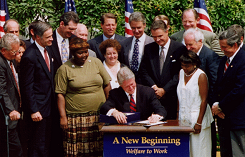- Published on
Historical Background of Welfare Reform Act of 1996
In 1996, Congress passed the Welfare Reform Act, known as the Personal Responsibility and Work Opportunity Reconciliation Act (PRWORA), a bill aimed at substantially reconstructing the welfare system. It replaced Aid to Families with Dependent Children (AFDC) with Temporary Assistance to Needy Families (TANF).

This legislation was designed to place time limits on government assistance, and required participants to engage in welfare-to-work activities. The Living Wage Coalition calls this legislation, “welfare deform,” reminding people that the bill does fulfill President Bill Clinton’s promise of “transforming welfare as we know it.” The worst of the welfare-to-work activities necessary to qualify for a monthly grant is “workfare” – menial and degrading work like picking up trash in streets and parks. Cities and counties have used the “no wage” labor of welfare-to-work participants to replace family-supporting public sector jobs, and provide subsidies to for-profit businesses.
